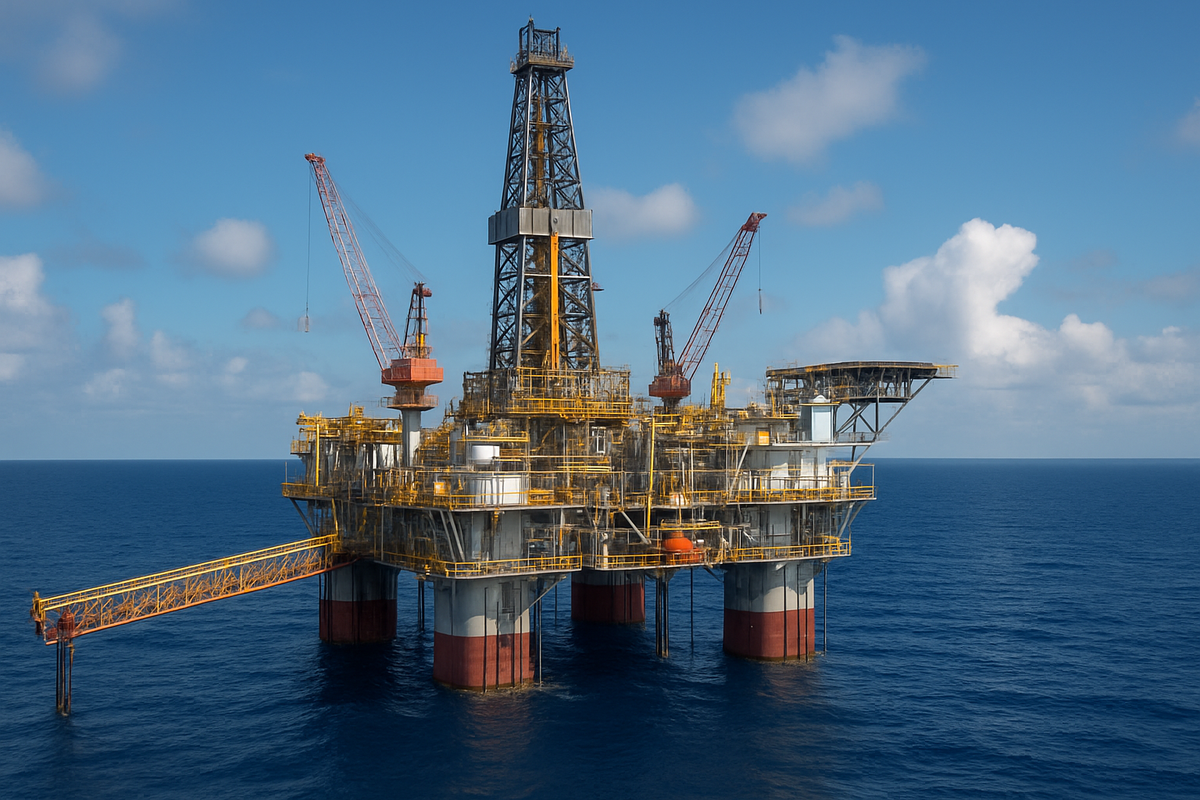
October 16, 2025 – The United States oil industry is witnessing a significant pivot, with deepwater drilling in the Gulf of Mexico (GoM) emerging as the primary engine for growth, even as onshore shale production faces an anticipated slowdown. This strategic shift marks a renewed era for offshore exploration and production, driven by technological advancements, favorable regulatory environments, and the economic allure of vast, untapped reserves beneath the ocean floor. The momentum in the GoM is not merely a fleeting trend but a fundamental recalibration of the nation's energy strategy, promising substantial implications for energy security and the financial markets.
This resurgence comes at a critical juncture, as the prolific shale plays that powered the US to become a global energy superpower show signs of maturity, with operators increasingly drilling in less productive areas. The deepwater GoM, conversely, is demonstrating robust project pipelines and attractive break-even costs, making it an increasingly viable and strategic alternative. This dynamic is poised to reshape investment flows, operational strategies, and the competitive landscape for major energy companies and service providers alike.
Offshore Giants Lead a New Wave of Production
The narrative of fading onshore production is being met with a compelling counter-story from the deep waters of the Gulf. As of October 2025, the GoM deepwater sector is experiencing a palpable surge in activity, with new projects coming online that are set to significantly boost US crude oil and natural gas output. The US Energy Information Administration (EIA) forecasts a rise in GoM crude oil production, projected to average 1.8 million barrels per day (b/d) in 2024 and increase to 1.9 million b/d in 2025. This growth is largely attributable to the anticipated startup of 12 new fields between 2024 and 2025, with seven utilizing subsea tiebacks to existing Floating Production Units (FPUs) and five leveraging four new FPUs.
Among the key players driving this expansion is Chevron (NYSE: CVX), whose deepwater Anchor field, operating at a water depth of 5,000 feet, commenced production in August. This project, with a capacity of 75,000 b/d of oil and 28 MMscf/D of natural gas, is notable for deploying 20,000-psi rated equipment, setting a new benchmark for high-pressure operations. Shell (NYSE: SHEL) is also a significant contributor with its Whale project, expected to begin production in late 2024 from a depth of 8,600 feet, forecasting 85,000 b/d. Other vital developments include the LLOG-operated Salamanca FPU, Shell's Rydberg (connecting to its Appomattox platform), Beacon Offshore Energy's Winterfell (tying back to Occidental Petroleum's (NYSE: OXY) Heidelberg platform), and Hess Corp.'s (NYSE: HES) Pickerel (linking to the Tubular Bells floating spar). These projects underscore a concerted effort by industry leaders to leverage advanced technology and existing infrastructure to unlock substantial deepwater reserves.
The initial market reaction to this deepwater resurgence has been largely optimistic. Analysts and industry executives view the GoM as a reliable, long-term source of hydrocarbons, particularly given its attractive economics. While initial capital expenditures for deepwater projects are substantial, break-even prices can be as low as $20 per barrel for some operations, a stark contrast to the average onshore break-even of $48 per barrel. This cost-efficiency, coupled with the strategic importance of GoM oil for US energy security, has fostered a positive sentiment, attracting significant investments and driving merger and acquisition activity, such as Talos Energy's (NYSE: TALO) recent acquisition of QuarterNorth Energy to bolster its GoM deepwater portfolio. Despite a projected temporary slowdown in US Gulf drillship activity in 2025, a strong recovery is anticipated in 2026, with long-term forecasts pointing to increased activity and robust fundamentals, as evidenced by Transocean (NYSE: RIG) securing new ultra-deepwater drillship contracts scheduled to commence this month.
Companies Poised for Gains and Losses in the Offshore Shift
The accelerating momentum in deepwater GoM drilling creates a clear bifurcation of fortunes within the energy sector, favoring companies with significant offshore assets, technological expertise, and robust balance sheets.
Potential Winners:
- Integrated Oil Majors: Companies like Chevron (NYSE: CVX), Shell (NYSE: SHEL), and BP (NYSE: BP) are already leading the charge with significant deepwater projects. Their vast capital resources, technological prowess, and global supply chain networks enable them to undertake complex deepwater developments. Chevron's Anchor field, Shell's Whale project, and BP's final investment decision for its Tiber-Guadalupe project exemplify their commitment. These companies stand to benefit from increased production volumes, diversified portfolios, and potentially higher margins from lower-cost deepwater barrels.
- Independent Deepwater E&P Companies: Firms such as Talos Energy (NYSE: TALO), which recently acquired QuarterNorth Energy to expand its GoM deepwater assets, are pure-play beneficiaries. Their focused strategies on high-impact deepwater prospects, often through strategic partnerships, position them for substantial growth. Talos Energy's reported profitability at $35 per barrel for its H2 2025 offshore projects highlights the economic viability of their operations.
- Offshore Drilling Contractors: Companies like Transocean (NYSE: RIG), Valaris (NYSE: VAL), and Diamond Offshore Drilling (NYSE: DO) are critical enablers. Increased deepwater activity translates directly into higher utilization rates and day rates for their ultra-deepwater drillships and rigs. Transocean's recent contract wins underscore this positive trend, indicating a strong demand outlook for specialized drilling services.
- Offshore Service and Equipment Providers: A broad ecosystem of companies supplying subsea equipment, well services, seismic imaging, and engineering solutions will see heightened demand. This includes firms like Schlumberger (NYSE: SLB), Halliburton (NYSE: HAL), and Baker Hughes (NASDAQ: BKR), which provide essential technologies and services for deepwater operations, as well as specialized subsea equipment manufacturers.
Potential Losers (or those facing adaptation challenges):
- Onshore-Focused E&P Companies: Companies heavily invested in mature onshore shale basins might face increasing pressure. As deepwater offers more attractive economics and growth prospects, capital allocation could shift away from onshore plays. While some diversified players will adapt, those without significant offshore exposure may see slower growth, lower valuations, and increased competition for investment dollars.
- Smaller, Less Capitalized Onshore Operators: These firms might struggle to compete for investment and talent if the industry's focus continues to pivot towards capital-intensive deepwater projects. The higher break-even costs of marginal onshore plays will further exacerbate their challenges.
The long-term success of these companies will hinge on their ability to manage the significant upfront capital requirements, navigate complex regulatory frameworks, and continuously innovate to maximize recovery and efficiency in challenging deepwater environments.
Wider Significance: Reshaping the Energy Landscape
The resurgence of deepwater drilling in the Gulf of Mexico is not an isolated event but a pivotal development fitting into broader, evolving industry trends. It signifies a strategic rebalancing in the US energy portfolio, recognizing the enduring value of conventional, large-scale hydrocarbon resources alongside the continued, albeit maturing, contributions of unconventional shale. This shift is driven by a confluence of factors, including global energy demand, the natural decline curves of mature onshore fields, and technological advancements that make deepwater extraction increasingly efficient and economically competitive.
This event has potential ripple effects across the entire energy value chain. For competitors and partners, it signals a renewed focus on long-cycle projects that require substantial upfront investment and long-term commitment. International oil companies and national oil companies globally, particularly those with deepwater assets in regions like Brazil, West Africa, and the North Sea, will likely monitor the GoM's success as a blueprint for their own strategies. The demand for specialized offshore equipment, engineering services, and skilled labor will intensify, benefiting a niche but critical segment of the industry. Conversely, onshore service providers might need to pivot their offerings or face reduced demand for their specific expertise.
Regulatory and policy implications are also significant. The current administration, under President Donald Trump, has shown a clear inclination towards supporting domestic oil and gas production, including offshore. This includes efforts to streamline permitting processes and discussions around reducing deepwater royalty rates, all aimed at incentivizing investment and lowering operational costs. Such policies provide a stable and predictable environment for long-term deepwater projects, which are inherently sensitive to regulatory uncertainty. Any future shifts in environmental policy or leasing programs could, however, introduce new challenges. Historically, the GoM has experienced cycles of boom and bust, often influenced by oil prices, technological breakthroughs, and regulatory changes. The current momentum echoes periods of intense deepwater development in the early 2000s, but with the added advantage of advanced drilling and subsea technologies, such as the 20,000-psi rated equipment, which unlock previously inaccessible reserves. This technological leap differentiates the current phase, suggesting a potentially more sustained period of growth.
What Comes Next: Navigating Opportunities and Challenges
Looking ahead, the trajectory of deepwater drilling in the Gulf of Mexico presents a dynamic interplay of short-term adjustments and long-term strategic opportunities. In the short term, specifically through late 2025 and into 2026, the industry anticipates a ramp-up in production from the recently commissioned and soon-to-be-operational projects. This influx of new supply from the GoM will contribute significantly to global crude oil supplies, which are projected to increase through Q4 2025 and into the first half of 2026, according to OPEC and various bank research teams. While a temporary lull in drillship activity is projected for 2025, a strong recovery is expected in 2026, signaling a sustained demand for specialized offshore assets.
Long-term possibilities include the unlocking of even deeper and higher-pressure reserves through continuous technological innovation, further solidifying the GoM's role as a strategic energy hub. The global deepwater drilling market is forecasted to grow at a Compound Annual Growth Rate (CAGR) of 6.80% from 2025 to 2032, reaching USD 166.41 billion, driven by persistent energy demand and the depletion of shallower resources. This sustained growth will necessitate continued investment in research and development for subsea technologies, advanced seismic imaging, and enhanced oil recovery techniques for deepwater environments.
Potential strategic pivots or adaptations required for companies will involve a heightened focus on capital efficiency, risk management for complex deepwater operations, and the development of specialized talent. Companies that can effectively integrate digital technologies, artificial intelligence, and automation into their offshore workflows will gain a significant competitive edge. Market opportunities will emerge for innovators in subsea infrastructure, floating production systems, and environmental compliance technologies tailored for deepwater. Challenges will include managing geopolitical risks, maintaining social license to operate amidst environmental concerns, and navigating potential supply chain disruptions for highly specialized equipment. Potential scenarios range from a steady, sustained growth trajectory, bolstered by stable oil prices and supportive policies, to periods of volatility if global demand falters or regulatory landscapes shift significantly. Investors should watch for further Final Investment Decisions (FIDs) on new deepwater projects, rig utilization rates, and the performance of key offshore service providers as indicators of the sector's health.
Wrap-Up: A New Horizon for US Energy
The narrative of US oil production is clearly pivoting towards the deep waters of the Gulf of Mexico. This strategic shift is driven by the maturing landscape of onshore shale plays and the compelling economics, technological advancements, and supportive regulatory environment that are breathing new life into offshore exploration and production. The GoM's deepwater sector is not just supplementing but increasingly leading US oil industry growth, promising substantial contributions to national energy security and global supply.
Key takeaways from this event include the robust project pipeline in the GoM, spearheaded by majors like Chevron (NYSE: CVX) and Shell (NYSE: SHEL), and the attractive break-even costs that make deepwater a competitive alternative. The industry's embrace of cutting-edge technologies, such as 20,000-psi rated equipment, is unlocking previously inaccessible reserves, signaling a new era of technical capability. Furthermore, a favorable regulatory climate under President Donald Trump is providing the stability and incentives necessary for long-term capital-intensive projects.
Moving forward, the market will likely see continued investment flowing into the deepwater sector, benefiting specialized E&P companies, drilling contractors like Transocean (NYSE: RIG), and a wide array of offshore service providers. While onshore-focused entities may face adaptation challenges, the broader energy market will benefit from a more diversified and resilient domestic supply. Investors should closely monitor new project announcements, the evolution of drilling technology, and global oil demand trends. The lasting impact of this deepwater resurgence will be a reconfigured US energy landscape, where the vast, complex, and technologically demanding reserves of the Gulf of Mexico play an increasingly central role in meeting the nation's and the world's energy needs for decades to come.
This content is intended for informational purposes only and is not financial advice




